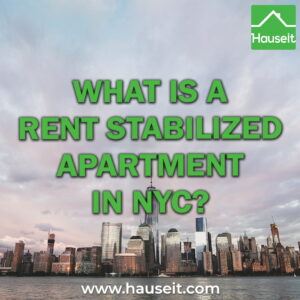Rent stabilized NYC apartments offer tenants several protections including limitations on annual rent increases and the right to renew with few exceptions. Allowable annual rent increases for rent-stabilized units are set each year by the New York City Rent Guidelines Board (NYCRGB).
The New York Department of Housing Preservation & Development estimates that there currently are about 1,048,860 rent stabilized units in NYC.
A NYC apartment may qualify for rent stabilization if it is in a building of six or more units built between 2/1/47 and 12/31/73. Tenants in buildings built before 2/1/47 who moved in after 6/30/71 may also qualify for rent stabilization. Condo and co-op buildings are generally exempt from rent-stabilization laws.
The rent stabilization program also covers buildings that receive 421-a, J-51 and 421-g tax benefits.
Not all apartments which meet this criteria are actually rent-stabilized. This is because prior to 2019 it was possible for apartments to be removed from rent stabilization if rent (or rent and a tenant’s income) exceeded certain thresholds.
Click on the sections below to learn more. Tired of renting? Estimate your buyer closing costs in NYC using Hauseit’s Buyer Closing Cost Calculator, and consider requesting a Hauseit Buyer Closing Credit to save money on your purchase.
Table of Contents:
How to find a rent stabilized apartment in NYC
What apartments qualify for rent stabilization in NYC?
What percentage of NYC apartments are rent stabilized?
How is rent stabilization different from rent control?
What is the history of rent stabilization in NYC?
Is my NYC apartment rent stabilized?
How do rents increase in rent stabilized apartments?
Am I entitled to a renewal if I live in a rent stabilized unit?
How to find a rent stabilized apartment in NYC
Rent stabilized apartments can be found by cross referencing available rental listings with the list of rent-stabilized buildings. You can also use the advanced search feature on rental websites to screen for listings which may have the word “stabilized” or phrase “rent-stabilized” in the listing description.
If you’re lucky enough to find a rent-stabilized apartment, make sure that the lease you sign includes a rent stabilized lease rider, as required by law.
You can also apply for discounted housing via a NYC affordable housing lottery.
While affordable housing units are initially subject to income restrictions and household size requirements, these units eventually become rent-stabilized apartments.
What apartments qualify for rent stabilization in NYC?
A NYC apartment may qualify for rent stabilization if it is in a building of six or more units built between 2/1/47 and 12/31/73. Tenants in buildings built before 2/1/47 who moved in after 6/30/71 may also qualify for rent stabilization. Rent stabilized buildings generally exclude condos and co-ops.
Not every apartment which meets the aforementioned guidelines is rent stabilized.
Prior to 2019, it was possible for an apartment to be removed from rent-stabilization if the rent met or exceeded the deregulation threshold (which was most recently $2,774.76).
An apartment could also be removed from rent-stabilization based on the tenants’ income and rents exceeding certain levels.
Units which leave the rent control program typically convert to rent stabilized units if the apartment is in a building with six more units constructed prior 1/1/1974.
The rent stabilization program also covers buildings that receive 421-a, J-51 and 421-g tax benefits.
A Full Service Listing for 1%
Sell your home with a traditional full service listing for just one percent commission.
What percentage of NYC apartments are rent stabilized?
Just under 50% of New York City’s 2.2 million rental units are subject to rent-regulation, which encompasses both rent-controlled and rent-stabilized apartments.
Rent stabilized apartments are considerably more common than rent controlled apartments. The New York Department of Housing Preservation & Development estimates that there are about 1,048,860 rent stabilized units in NYC compared to just 16,400 rent controlled units.
How is rent stabilization different from rent control?
While rent control and rent stabilization are both forms of ‘rent regulated’ housing in NYC, they have different sets of regulations.
Protections afforded to tenants of rent stabilized units include the following:
-
Limitations on the amount of rent increase
-
Tenants have the right to renew the lease
-
Tenants are entitled to receive required services
-
Landlords have limited ability to evict
The allowable annual rent increase is set by the New York City Rent Guidelines Board (NYCRGB).
Under rent control, tenants are considered to be “statutory” tenants. There are strict limitations on how much rent a landlord can charge and the owner’s ability to evict tenants.
What is the history of rent stabilization in NYC?
Rent regulation in NYC dates back to World War II. During and after the war, there was a severe nationwide housing shortage and bout of inflation. This prompted the federal government to actively regulate rents across the country between 1942 and 1950.
Federal rent regulation started with the Emergency Price Control Act (EPCA) of 1942 which was signed into law by President Franklin D. Roosevelt.
As the housing shortage eased, federal rent regulation continued, albeit in a slightly diluted manner, with the Housing and Rent Act of 1947 which was signed into law by President Harry S. Truman. Federal regulation of rents ultimately wound down in 1950.
In 1951, New York State enacted its own rent regulation framework to fill the void left by the federal government’s withdrawal from rent regulation. The concept of modern day rent-stabilization in NYC came into existence with the passage of the Rent Stabilization Law of 1969 (RSL).
There have been a number of legislative updates to the rent regulation framework in New York and NYC over the years, most recently in 2019 with the passage of the Housing Stability and Tenant Protection Act (HSTPA).
Is my NYC apartment rent stabilized?
The only definitive way to determine if your NYC apartment is rent stabilized is to contact the Office of Rent Administration at the NYS Homes and Community Renewal (HCR). You can reach the Office of Rent Administration by calling +1 (833) 499-0343 or by submitting a request online.
However, your apartment is highly unlikely to be rent-stabilized if you fall into any of the following categories:
-
Your building has fewer than six units
-
You live in a condo or co-op building
-
Your building was constructed after 12/31/73
Even if your building meets the criteria for rent-stabilization, your specific apartment may have been deregulated in the past. This is why the only definitive way to verify the rent-stabilization status of your specific apartment is to contact the Office of Rent Administration.
A Full Service Listing for 1%
Sell your home with a traditional full service listing for just one percent commission.
How do rents increase in rent stabilized apartments?
Allowable annual rent increases for “rent stabilized” units are set each year by the New York City Rent Guidelines Board (NYCRGB).
For lease renewals beginning between October 1, 2021 and September 30, 2022, the permissible rent increase for rent stabilized apartments is as follows:
-
For a one-year lease commencing on or after October 1, 2021 and on or before September 30, 2022: 0% for the first 6 months of the lease and 1.5% for the remaining 6 months of the lease.
-
For a two-year lease commencing on or after October 1, 2021 and on or before September 30, 2022: 2.5%
For lease renewals between October 1, 2022 and September 30, 2023, the permissible rent increase for rent stabilized apartments is as follows:
-
For a one-year lease commencing on or after October 1, 2022 and on or before September 30, 2023: 3.25%
-
For a two-year lease commencing on or after October 1, 2022 and on or before September 30, 2023: 5%
Prior to the passage of The Housing Stability and Tenant Protection Act (HSTPA) in 2019, a rent regulated apartment could be deregulated if the annual rent met or exceeded the deregulation threshold. This threshold was most recently $2,774.76 in 2019. Here are the historical deregulation thresholds for NYC:
-
$2,000: Tenant moved-in between 1993 and June 23, 2011
-
$2,500: Tenant moved-in between 6/24/11 and 6/14/15
-
$2,700: Tenant moved-in between 6/15/15 and 12/31/17
-
$2,733.75: Tenant moved-in between 1/1/18 and 12/31/18
-
$2,774.76: Tenant moved-in between 1/1/19 and 6/13/19
Landlords of rent stabilized apartments may also be entitled to a rent increase by making individual apartment improvements (IAI) or building-wide major capital improvements (MCI). Refer to this fact sheet for more information.
Am I entitled to a renewal if I live in a rent stabilized unit?
Tenants of rent stabilized apartments in NYC have the right to renew with very few exceptions. A landlord may only decline to offer a lease renewal in certain scenarios which may include:
-
The owner or a member of the owner’s immediate family needs the apartment for their personal use and primary residence. If the tenant is a senior citizen, or disabled, special rules apply
-
The tenant is not using the apartment as a primary residence
-
The owner wants to take the apartment off the rental market, either to demolish the building for reconstruction or use it for other purposes permitted by law.







